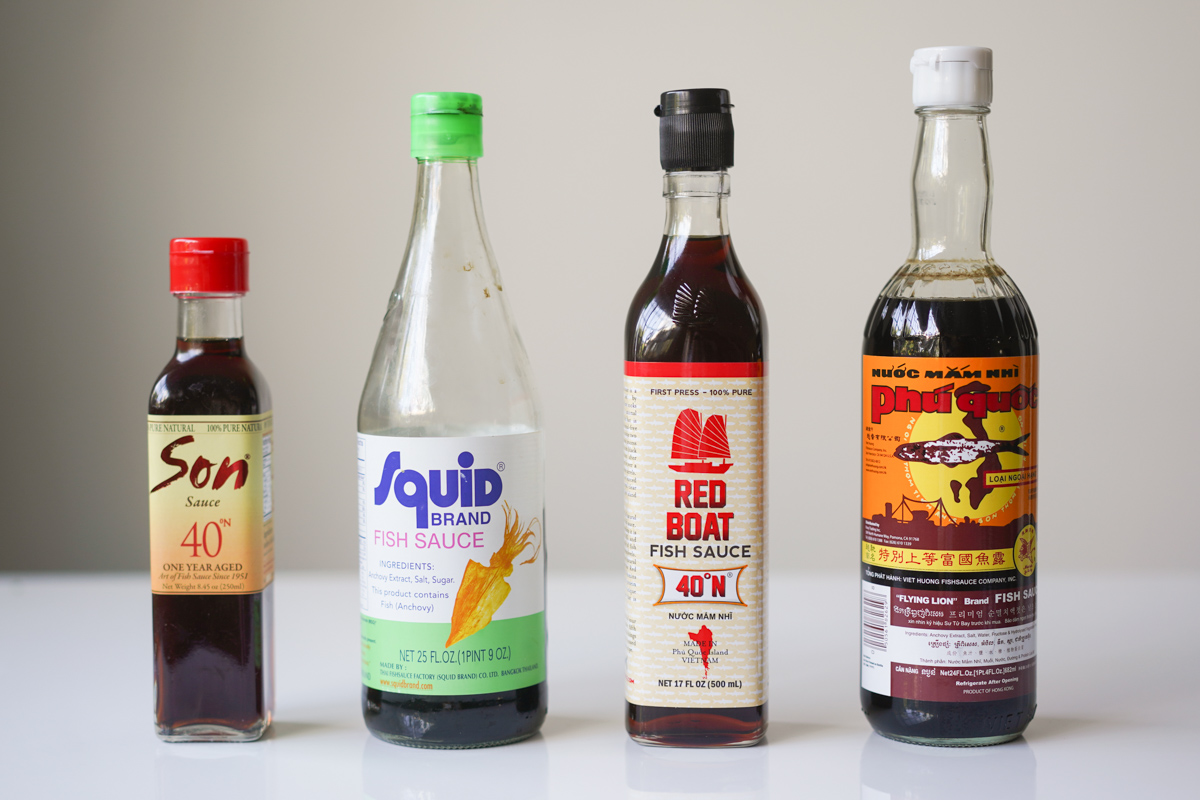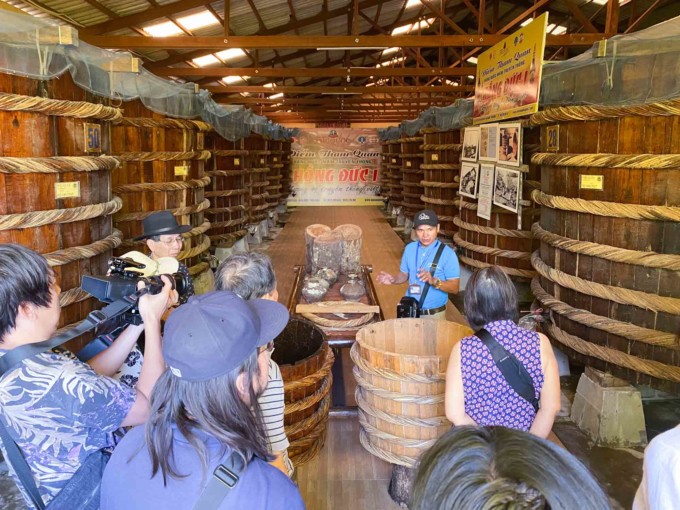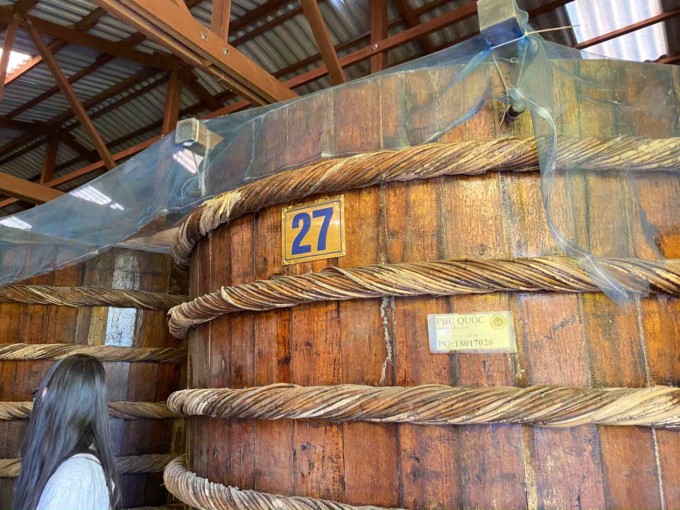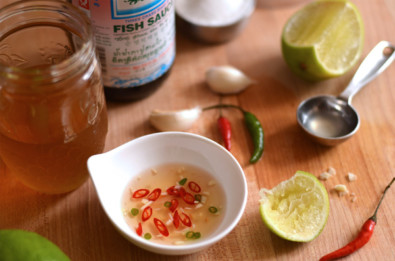
Fish sauce. The mere mention of this stuff strikes fear in the hearts of many. It’s an incredibly pungent, fishy concentrated liquid that even southeast Asian cooks knowingly handle with caution. A spilled bottle will undoubtedly leave a very stinky lasting impression. Like a lot of Asian foods in America, this potent flavor powerhouse suffers from the unfortunate stigma of “fishiness.” Just imagine if it was called “magical umami liquid gold,” because that is precisely what it is that for the greater part of southeast Asia!
Luckily for us, American home cooks and culinary experts are waking up to the revelatory flavor-enhancing qualities of fish sauce. Chefs in Spanish, Mexican and American restaurants have experimented with fish sauce for its umami superpowers. From anything to potatas bravas, salsa verde, poblano sauce, barbeque or even bloody mary cocktails, its power to transform flavor is too much to resist for anyone who’s in-the-know.
For examples of recipes where fish sauce is prominently used, check out my recipes for egg rolls, and the noodle bowl like bun thit nuong.
What is fish sauce made of?
In its purest form, modern fish sauce consists of anchovies and sea salt as the only ingredients. Traditionally, anchovies are crusted in sea salt and packed in barrels where they are left to ferment. Natural bacteria then breaks down the fish with magical alchemy (aka fermentation), transforming it into a super funky, briny liquid. It can take months or up to two years to completely ferment. Raw types are processed at room temperature, maintaining all of its enzymes and omega-3 fatty acids.
As the story goes with mass-produced products, companies start to stray from the original formulation as they aim to cut costs. Lower-quality products contain more fillers or enhancements like water, sugar or other flavorings. The exception is of course is the vegetarian substitute, which replaces anchovies altogether. Here is a list of popular brands and their ingredients:
- Red Boat Premium Fish Sauce – Anchovies, sea salt
- Premium Anchovy Fish Sauce Gold – Anchovies, sea salt
- “Flying Lion” Vietnamese-Style Fish Sauce – Anchovy extract, water, salt, fructose and hydrolysed vegetable protein
- Three Crabs Brand Fish Sauce – Anchovy extract, water, salt, fructose and hydrolysed vegetable protein
- Thai Kitchen Sauce Fish – Anchovy extract, salt, sugar
- Vegan Fysh Sauce – Organic seaweed, pineapple extract, rice wine, vinegar and other ingredients
- Golden Boy Brand Fish Sauce – Anchovies, salt and sugar
- BLiS Barrel Aged Fish Sauce – Fresh black anchovy, sea salt
How and where is fish sauce used?
Though it was originally invented in China 2300 years ago, fish sauce traveled south and evolved to become more of a staple in southeast Asian countries. You’ll find different versions in Indonesia, Burma, Cambodia, The Philippines, Thailand, Laos, and Vietnam. It’s as essential to Vietnamese and Thai cuisine as soy sauce is to northern neighbors China, Japan and Korea. In other words, it’s akin to salt in the American kitchen. Whether its used straight from the bottle for cooking or mixed with other ingredients to make different dipping sauces, its usage varies between different countries.
If you’ve had pad thai, pho, egg rolls or vermicelli noodle salad, you’ve definitely had fish sauce in some form or another. Let’s take a look at different ways that it’s used in different cuisines.
Vietnamese fish sauce: nuoc mam
In Viet Nam Culture Foundation, Trần Ngọc Thêm wrote, “For Vietnamese people, a meal without fish sauce is considered incomplete.” It is so prevalent in Vietnamese cuisine that you will find a small bottle of fish sauce on every dining table in place of table salt. Nuoc mam, as its known in Vietnamese, is the fundamental building block of Vietnamese cuisine. Used in both cooking as the main source of salt and as a dipping condiment, there are few dishes that exist without it.
Here are just a few common Vietnamese dishes featuring fish sauce as a primary ingredient:
- Vietnamese dipping sauce (Nuoc cham) (my recipe!)
- Vietnamese pork chops
- Vietnamese pork & shrimp summer rolls
- Grilled chicken wings
Nuoc cham
The central Vietnam region known as Hue is known to have the most clever uses of nuoc mam. As the former royal capital of the country, Hue has a rich culinary history of elaborate, labor-intensive dishes that are very distinct from other regions. Here, there are reportedly thirty different kinds of nuoc cham, a dipping sauce made with nuoc mam.
Nuoc cham is the Swiss army knife of Vietnamese sauces. By mixing nuoc mam with sugar and acid (typically lime), it does the work of salting and cutting through fried foods. In a variety of bun dishes (vermicelli rice noodle bowls), its acts as a vinaigrette-type dressing. For cha gio (eggrolls) or goi cuon (spring rolls), it’s a tangy dipping sauce.
It’s really no exaggeration that fish sauce is in virtually every Vietnamese dish. It is poetically synonymous with Vietnamese identity. Writer Thêm proposes that as rice represents the earth, nuoc mam symbolizes water as it’s made of the two “gifts of the sea”: anchovies and salt. For Vietnamese people, nuoc mam is as essential as water in the balance of nature.
Thai fish sauce: nam pla
Nam pla literally means “fish water” in Thai. It’s made similarly to the Vietnamese version except it is traditionally fermented in large earthenware jars instead of wooden barrels. Kasma Loha-unchit of Thai Food and Travel states that high quality nam pla should have a, “pleasant aroma of the sea, not an overwhelming smelly fishiness, and should not be overly salty.”
Like nuoc mam in Viet Nam, nam pla is the cornerstone of Thai cuisine. It is used in place of salt, acting also as a marinade and umami-enhancing agent. Loha-unchit recommends brands Cha Trang and Golden Boy for their pureness and flavor.
Here is just the tip of the iceberg of Thai recipes that feature nam pla:
- Pad Thai
- Thai Red Curry
- Thai Beef With Basil and Chilies
My grandma’s and other chefs’ kitchens
Back in my grandma’s kitchen, she would add fish sauce to pasta sauce for a secret umami kick–a trick that renowned chefs would later catch onto. Whether you consider this sacreligious or a stroke of genius, you can’t argue with the resultant health benefit of lowering 10-25% of sodium chloride without losing perceived umami and saltiness! For those watching their sodium intake, Food & Wine suggests using fish sauce as a low-sodium mitigator for salt.
What’s the best fish sauce?

Arguably, the best fish sauce in Vietnam, and maybe the world, is made on Phu Quoc Island, off the coast of Vietnam. Anchovies caught along the 22-island archipelago are salted and fermented in large wooden vats for up to one year. This sauce is so coveted that the “Phu Quoc” name can only be used for sauce actually made on the island, according to the Protected Designation of Origin status assigned to it by the European Union.
The following brands use fish from Phu Quoc exclusively:
- Phu Quoc
- Red Boat – 40 Degrees North
- Flying Lion
The pure taste of this fish sauce is attributed to the abundant waters off Phu Quoc, which team with plankton, the preferred food of anchovies. However, there are many imitators. Some brands dilute the fish sauce with seawater. The highest quality brands are labeled as a 43g/L. The number decreases as the sauce is further diluted with sea water (range: 40, 30, 20 and finally 15g/L). On Phu Quoc, the first run, produced when the vats are first drained, is considered the best.
Fish sauce substitutes
I’ve had some great tasting fish sauce alternatives from vegetarian Vietnamese restaurants that have their own take on this. Keep in mind that fish sauce substitutes are meant to be just that–substitutes. But nothing is a one for one replacement for the real sauce made with anchovies, even if they are still delicious in their own right.
If you’re vegan, vegetarian or just would rather use something else, I’ve seen others substitute fish sauce with these:
- Soy sauce
- Mixing hoisin and miso sauce
- Worchestshire Sauce
- Vegetarian “fish” sauce
How is fish sauce made?

Making homemade fish sauce is a great way to ensure that you know exactly what’s in it, however in terms of time invested, I’m not sure its worth it for most people. Also, you can skip the additives and preservative found in many off-the-shelf brands. However, it’s not for the faint of heart. It’s smell extremely pungent, but once it’s fermented it packs the same flavor punch as the manufactured fish sauce.
The following recipe, from dietitian Anne Guillot, takes 15 minutes of preparation and makes one bottle. It gives us an idea of how you could make it, if you are so ambitiously inclined.
Ingredients:
- Small anchovies (whole) – 1.5 lb.
- Sea salt – 3 tablespoons
- Water – 2 cups
- Garlic – 2 cloves (mashed)
- Bay leaves (crumbled) – 2
- Black peppercorns – 1 teaspoon
Instructions:
Toss the fish in salt and store in a mason jar. Press the fish down in the jar and add the remaining ingredients. Add more water, if needed, to cover the fish. Leave one inch of space below the jar lid, then cover tightly and ferment at room temperature for three days. After that, transfer the jar to the fridge. After a few weeks, you can take it out of the fridge and strain it. More the strained liquid into a bottle and refrigerate the fish sauce once more. After six to eight months, the sauce is ready to use and should appear clear and dark.
Again please note that the sight and smell of the fermentation process can be pretty hard to take for some people. When you use it, one or two tablespoons should be enough. You may need to add more salt since your homemade fish sauce isn’t as salty as store brands.









